 Written by Mike Price, OT
Written by Mike Price, OT
Falls are a real risk for people with mobility, strength, and balance issues. That risk is heightened in the potentially slippery environment of a bathroom. We know shower chairs make showering safer for people with mobility challenges, and allow them to maintain dignity and independence while bathing themselves by providing a stable and secure in-shower platform to sit on and bathe without the fear of falling in the shower.
Shower chairs, also known as tub chairs, shower seats, shower benches, shower stools, and sometimes commode chairs, are water-resistant seating solutions that go inside a shower or tub to provide people who have difficulty standing in the shower a safe seat so they can bathe in comfort and confidence.
In our experience, the stability provided by a shower seat is appropriate for people who have significant balance issues, tire easily, have leg weakness, and are at a high risk of slipping and falling.
Shower chairs are not generally covered for home use under Medicare Part B. Certain Medicare Advantage plans may offer over-the-counter allowances that can cover some items, like a shower chair, so review your plan benefits to see if a shower chair is covered.
It depends on where the shower chair will be used and who will be using it. The best chairs have adjustable leg rests and backrests for an individual fit, and they have rubber footing to minimize the chance of slippage in a wet bathtub. Most chairs usually have drainage holes in the seat to keep standing water from pooling. If getting on and off the toilet is difficult, we recommend a shower chair with a commode seat that can be rolled right over the toilet while sitting on it. For people who have greater support needs because of limited mobility and stability, we recommend options that include power bath lifts that caregivers can use to help the user transition to bathing.
Since falls are the leading cause of injury among older adults and bathrooms are typically smaller spaces where mobility aids don’t always fit: bathing, showering, and transferring in and out of the tub present a high risk for a fall without the support of a shower chair.
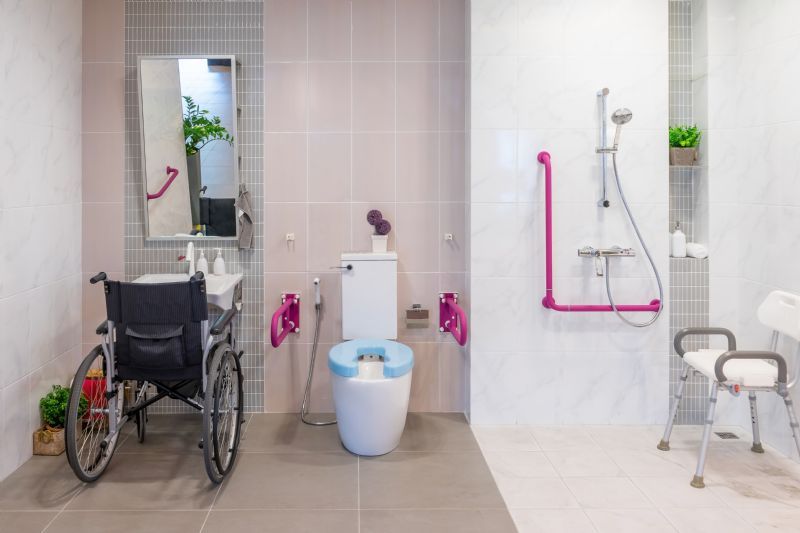
The materials that go into a piece of equipment that will be used in a wet environment need to be water-resistant, rust-proof, and durable. Choices for a frame are usually between aluminum and plastic. In our experience, aluminum tends to cost more than plastic. Some of the seats are made of hard plastic, some have mesh upholstery, and some are upholstered in antimicrobial materials. The main considerations are that the chair fosters a clean environment by being easy to clean and that it holds up when wet.
Users with low vision will appreciate contrasting colors to distinguish shapes. Many shower chairs are bright blue to make them easy to see and lower the risk of a fall from not being able to find the shower seat.
Shower chairs are available in a variety of sizes. Standard chairs have a weight capacity of between 250 pounds and 400 pounds. For users who weigh more than that, bariatric models are available serving users weighing up to 900 pounds.
Shower and bathing chairs come in different sizes, to accommodate not only users but differing tub and shower sizes. It is imperative to measure your bath/shower space before choosing a shower chair and keep in mind not every model will fit every design. Some chairs are narrow, some have wheels for walk-in showers, and some are wall or tub-mounted.
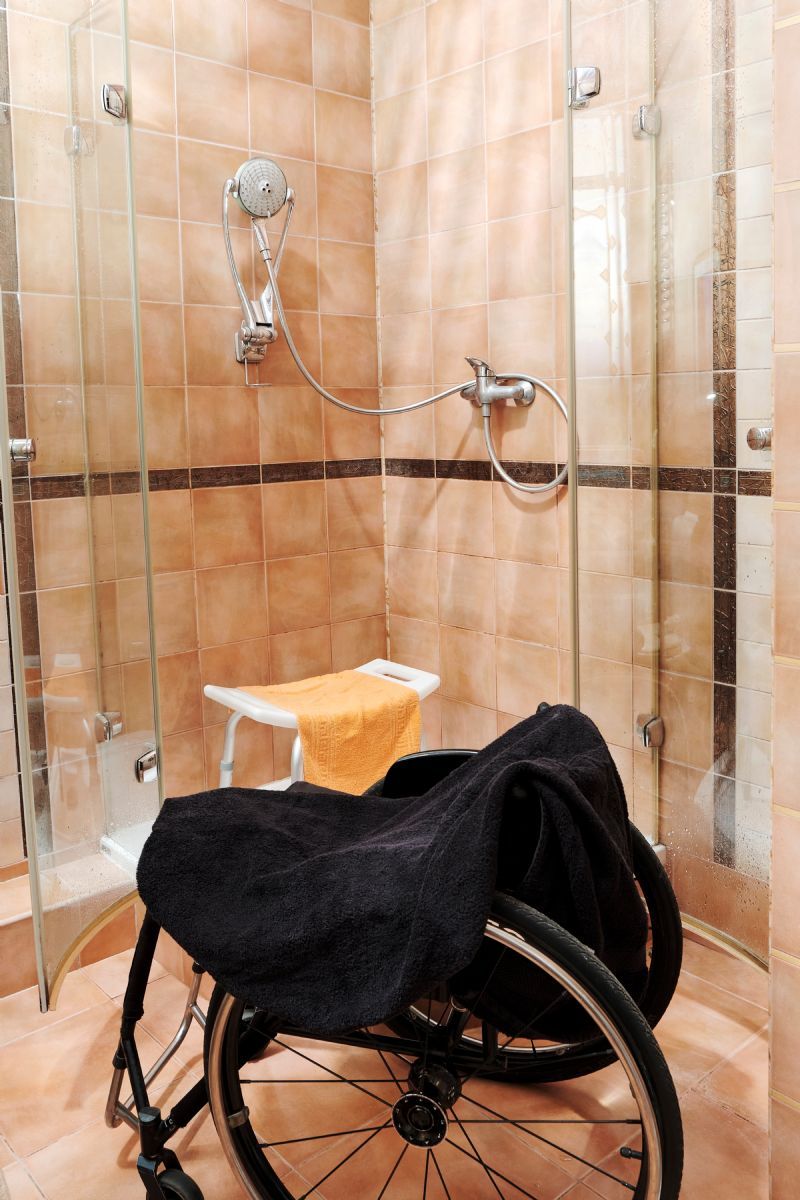
To foster skin health, it’s best not to sit in pooling water. Many shower chairs have drainage holes so water drains during the shower. Eliminating standing water also makes the shower seat easier to dry off and keep clean and hygienic.
The size and shape of a shower chair are about comfort but also proper support. For people who are recovering from hip surgery, a triangular shape and/or an available tilt will help take the pressure off the healing hip joint. If a seat is too narrow or not deep enough for a user to be stable while seated, it is not only uncomfortable but also unsafe. The seat needs to be the proper shape, size, and height to provide the stability and support to keep the user balanced and confident while bathing.
Bathing is about cleanliness, and any accommodation for maximum cleanliness should be considered. A perineal cut-out in a shower chair gives access to body parts that would be hard to easily wash while seated in a standard chair without a cut-out.
We know not every shower chair has adjustable legs, but most do. To ensure a customized and secure fit, measure the height you need and make sure the chair you choose can accommodate the height range you need.
Different users need different levels of support. Backrests, armrests, handholds, footrests, and straps that keep a user properly positioned are all options for support to provide a safe and secure bathing experience.
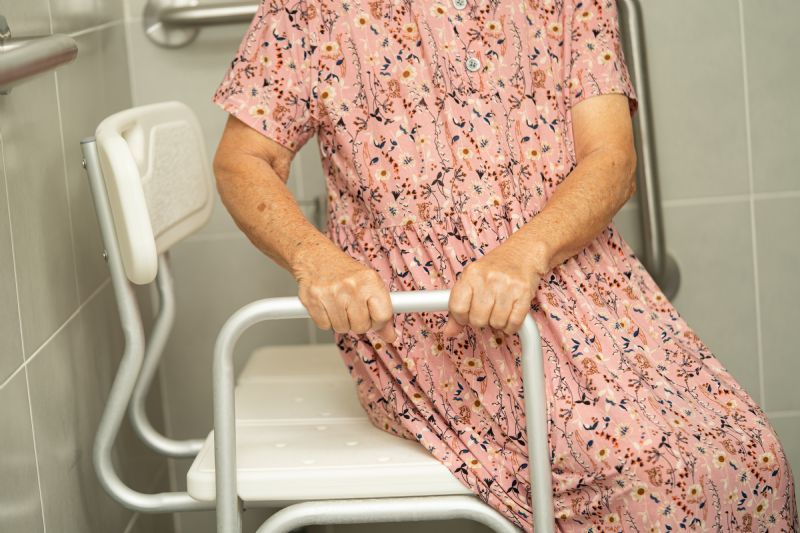
Feet options include suction cups, rubber pads, or locking casters. No matter what option you consider, the feet should always be checked before the user gets on the shower chair to make sure they won’t slip and have not changed positions between uses.
A padded seat can reduce pressure on the skin, decreasing the risk of developing pressure ulcers. For users who are at a high risk of developing pressure wounds from sitting in one position for extended periods, purchasing a ROHO Shower Commode Seat Cushion can defend against pressure ulcers.
Maintaining hygiene is one of the most important factors in creating and maintaining and healthy environment. Because many disabled people are immunocompromised, this becomes even more important. Shower seats that are made with materials that have antimicrobial properties keep germs at bay and foster a cleaner environment.
Every shower chair is designed to reduce the risk of a bathroom fall and help users maintain the highest possible level of independence. But with different shapes and sizes of people (and bathrooms) and different levels of mobility to consider, there are several types of shower chairs to choose from.
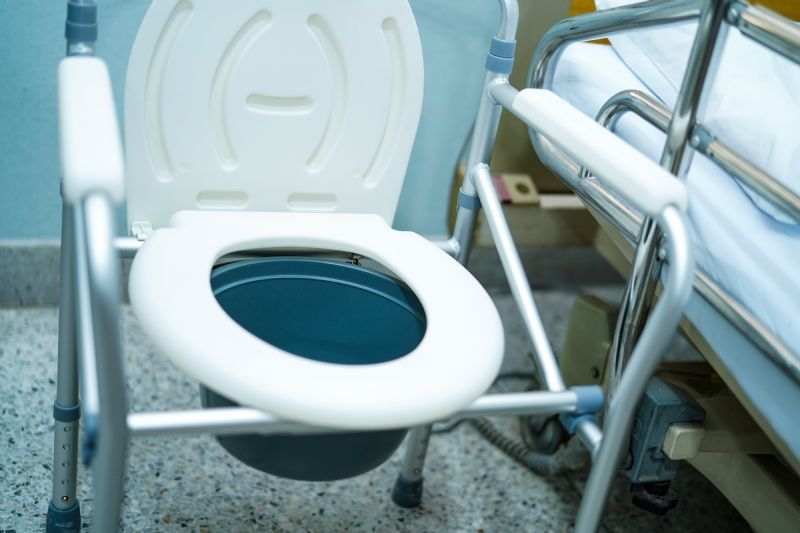
A shower commode chair has an open seat for use in the shower or it can be positioned over the toilet. These seats are designed to assist people who have difficulty transferring on and off a toilet safely and standing for long periods in the shower. Remodeling a bathroom to accommodate a disability can be avoided with a shower commode chair that fits the tub or shower and can be rolled over the open toilet bowl. We invite you to read The 5 Best Shower Commode Chairs for more information on the top shower commode chairs we offer.
We recommend: Bonn Shower Commode Chair with Wheels by Rebotec
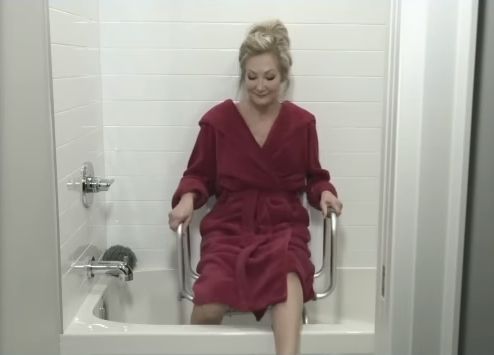
A shower chair with a back provides extra stability for the user. This protects the person in the shower from falling over backward and generally provides a more supportive option than a backless seat. This type of shower seat also typically comes with removable armrests and a grip handle on the backrest. Generally, a shower chair with a back is recommended for anyone.
We recommend: Inno Swivel Shower Chair
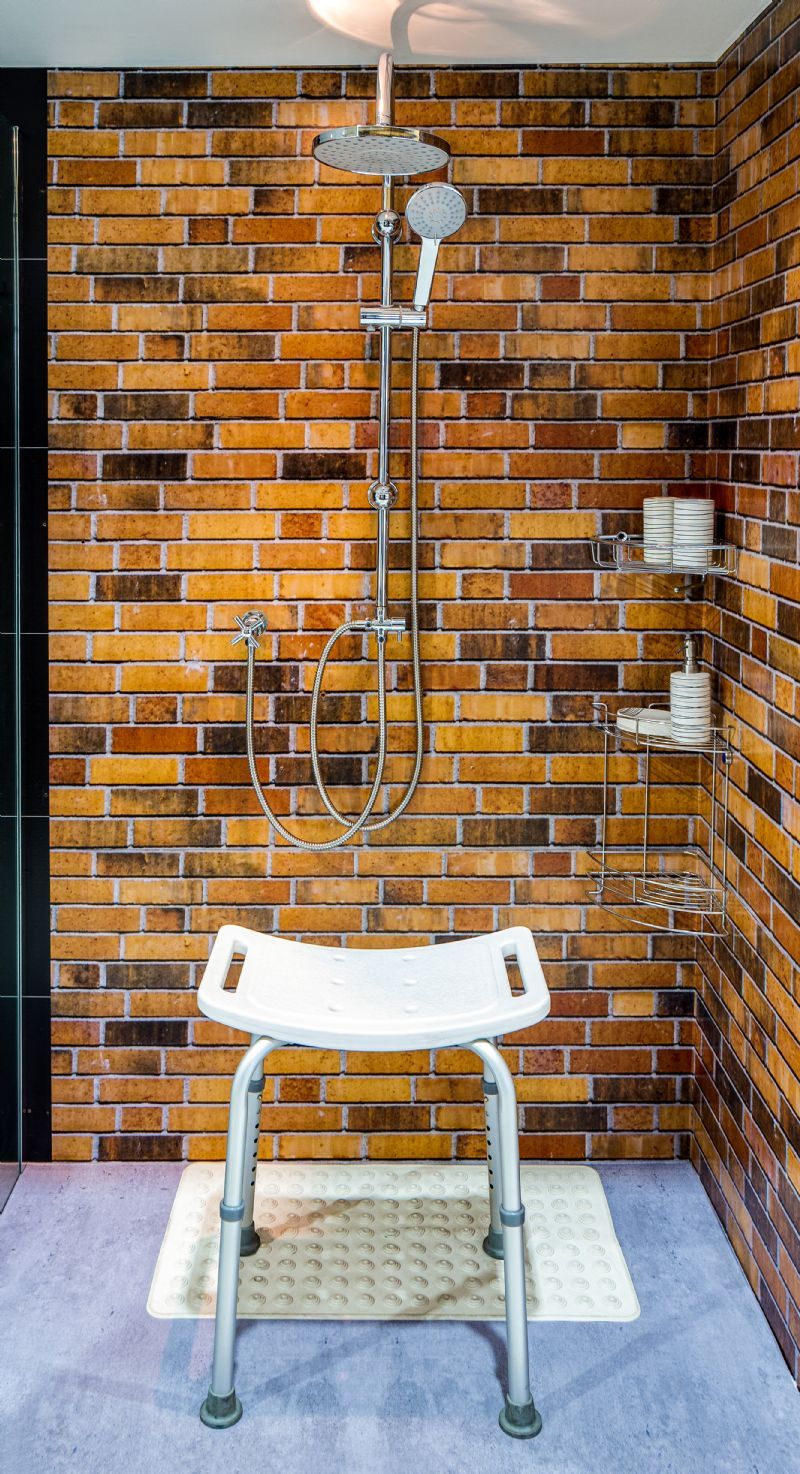
For users who don’t need as much support, and just need a place to sit, a shower chair without a back will work fine. Shower seats without backrests are less cumbersome to position and provide a more open bathing environment.
We recommend: Lightweight Adjustable-Height Shower Chair by Karman Healthcare
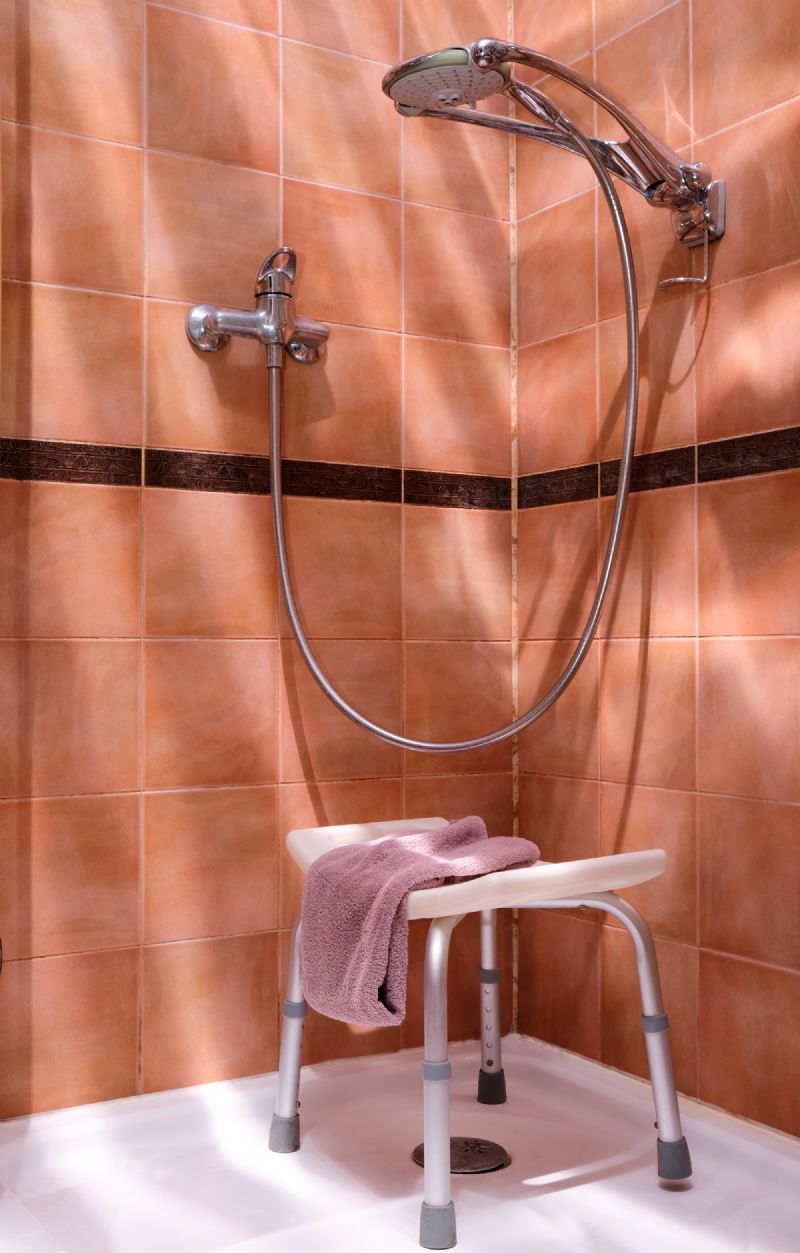
Stools are more compact shower seating options, which means they fit well but are more narrow and don’t have backrests. A popular feature of some shower stools is that they swivel, which can make it easier to get into position for safe transfer in and out of the tub.
We recommend: McKesson Aluminum Shower Stool
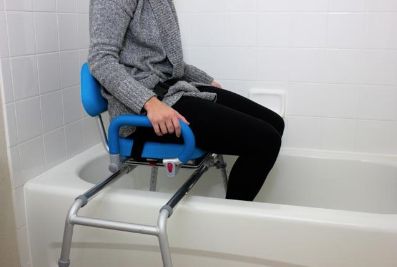
Although technically not a shower chair, the terms are sometimes used interchangeably, and a shower bench is sometimes called a rolling shower chair or a transfer bench. Shower or transfer benches are designed to straddle the tub with two legs inside the tub and two outside. They are bulky, but they provide great support when entering and exiting the tub. Shower chairs can only offer support once you are inside the tub. Allowing people to independently bathe helps users maintain their independence as long as possible. We have separate articles on the 5 Best Bathtub Transfer Benches and Top 5 Best Bath Benches with Cutout to help you be as informed as possible when making your purchasing decision.
We recommend: Carousel Sliding Transfer Bench with Swivel Seat by Platinum Health
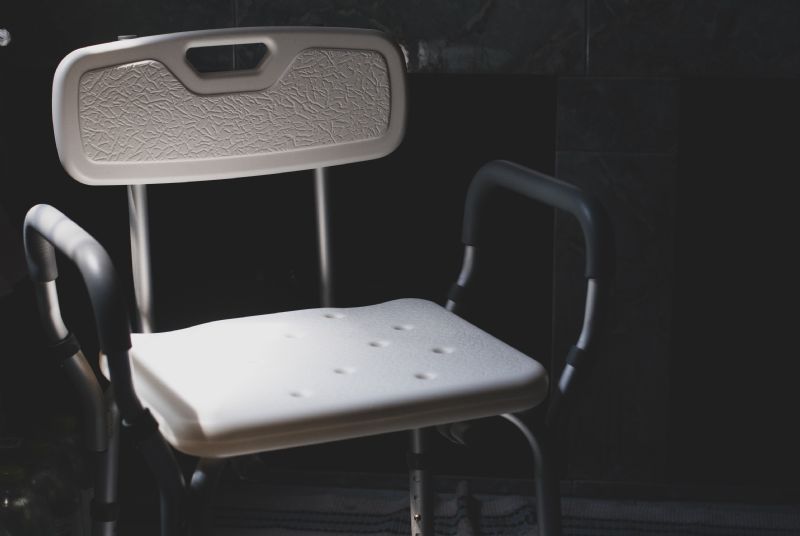
People who are recovering from hip surgery need to limit excessive hip flexion while they heal, and they need to be able to take care of their personal care needs without putting too much strain on their healing joints. Post-op surgery patients can get a shower chair with an adjustable seat angle that facilitates ease of egress and also limits hip flexion to support healing.
We recommend: Apex Hip Chair and Shower Chair by Platinum Health
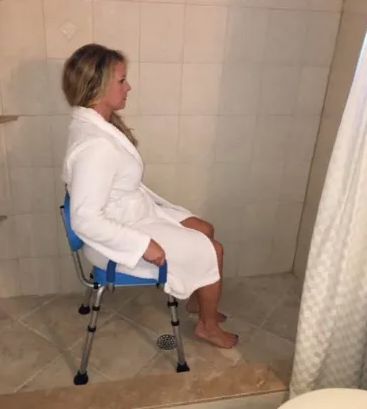
For people with low vision who benefit from contrasting colors to distinguish shapes, brightly colored shower chairs that don’t blend in with the shower stall walls make it easier to see and get settled into a shower chair.
We recommend: Deluxe Shower Chair with Arms by Platinum Health
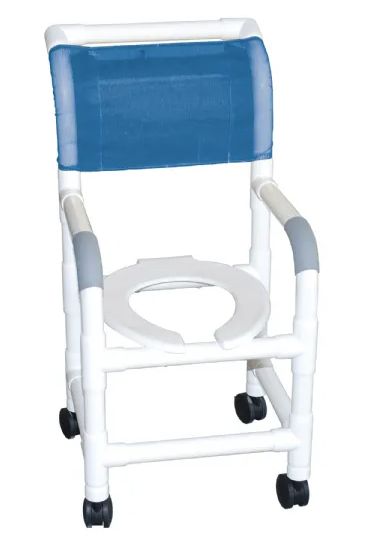
Pediatric shower chairs have the same benefits as their adult-sized counterparts. However, the chairs built for children are designed to adjust and expand to match the child’s growth, extending the service life of the chair before it is outgrown. For more information on the top pediatric shower chairs, our article on the Top 5 Best Rolling Pediatric Shower Chairs will provide a more in-depth look.
We recommend: Narrow PVC Shower Commode Chair for Pediatrics
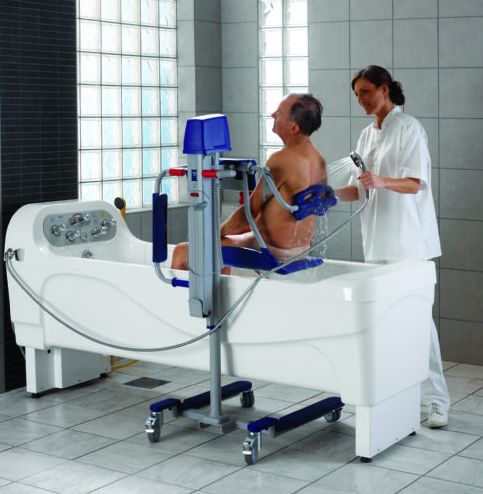
Tall people often have challenges in finding clothes, furniture, and medical equipment that are appropriately sized. Shower chairs with tall, adjustable legs will provide the comfort and security that a smaller, uncomfortable chair will not provide for taller users, making the bathing experience more relaxed and enjoyable.
We recommend: Calypso Height-Adjustable Bath and Shower Chair
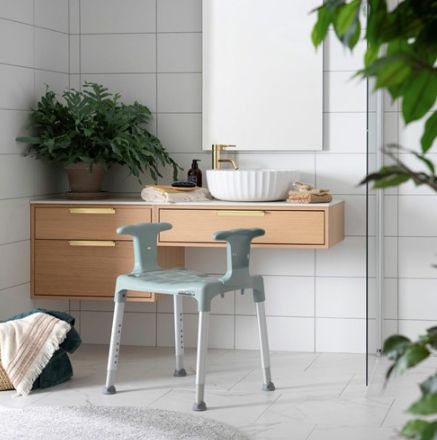
According to the Americans with Disabilities Act, the standard height for a shower chair ranges between 17 and 19 inches. They can be purchased with a height range of 14 to 17 inches, and the actual appropriate seat height is achieved when your knees are bent at 90-degree angles and your feet are flat on the floor.
We recommend: Etac Swift Shower Chair
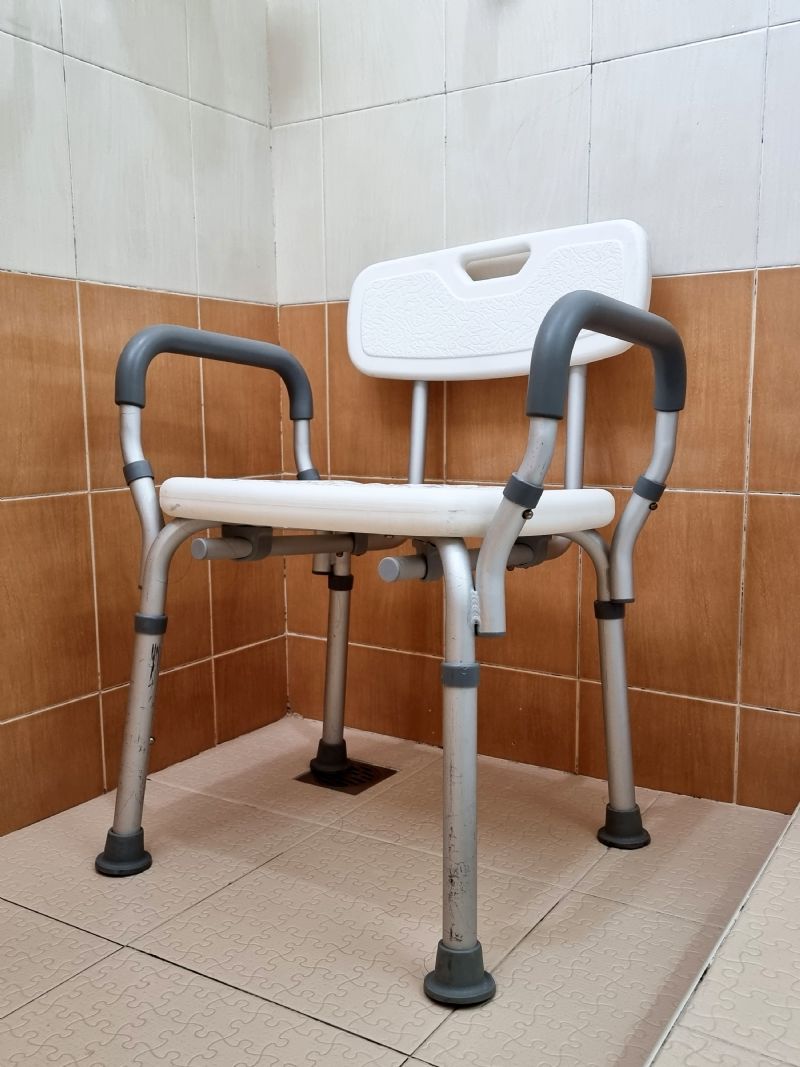
A standard shower chair can accommodate users up to 400 pounds. Bariatric models can accommodate users up to 900 pounds, although most common among bariatric models are in the 500-600 pound weight capacity range. See our Bariatric Shower Chair list for products in this category.
We recommend: ProBasics Bariatric Bath Chair with Back
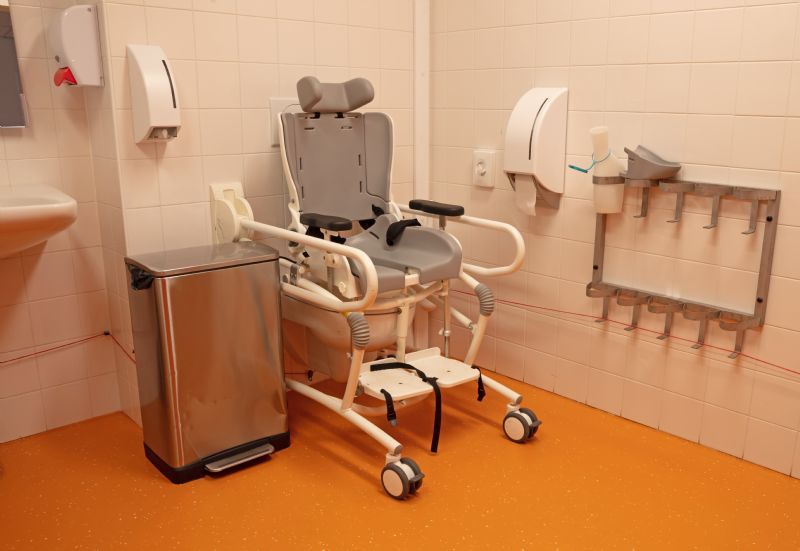
A reclining shower chair is also known as a recumbent shower chair or a tilt shower chair. The back and leg support tilt in unison and recline separately from the leg support to provide a wide variety of positions for safety and comfort. They provide secure support for persons with weaker legs and/or lack upper body strength. In a tilted position, the patient can feel more secure about their body position and safety. In our experience, this design also helps a caregiver find the optimal position for efficient assisted bathing.
We recommend: Platinum Health Laguna Reclining Shower Chair
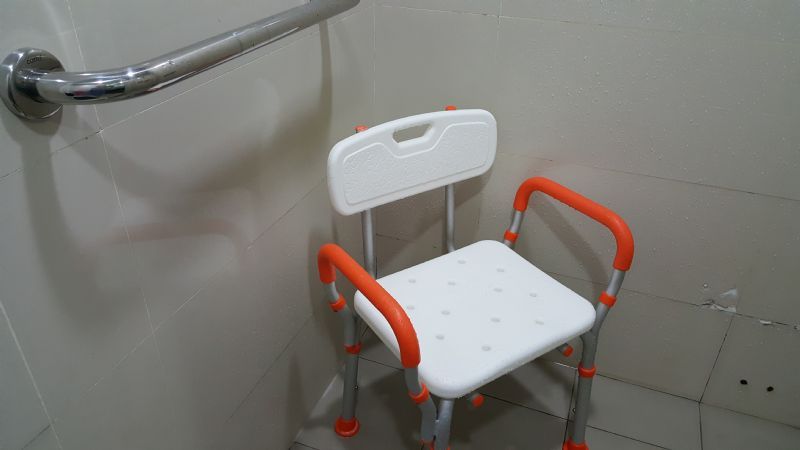
Shower chairs and stools that have swivel seats provide transfer assistance in and out of the shower or bath. There is no scooting or twisting required, and it is helpful for people who bathe independently or have the assistance of a caregiver.
We recommend: Platinum Health Revolution Swivel Shower Chair
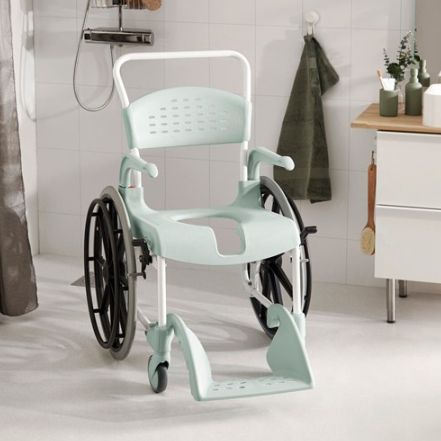
Shower wheelchairs, also known as bathroom wheelchairs, make hygiene maintenance easier for those who can’t walk to the bathroom. They feature an opening in the seat so users can independently use the toilet without getting out of the chair. When transferring to a shower, unless it is a lipless shower, caregiver assistance will be required to get the chair in and out of the shower.
We recommend: Etac Clean Self-Propelled Wheelchair Shower/Commode Combo Chair
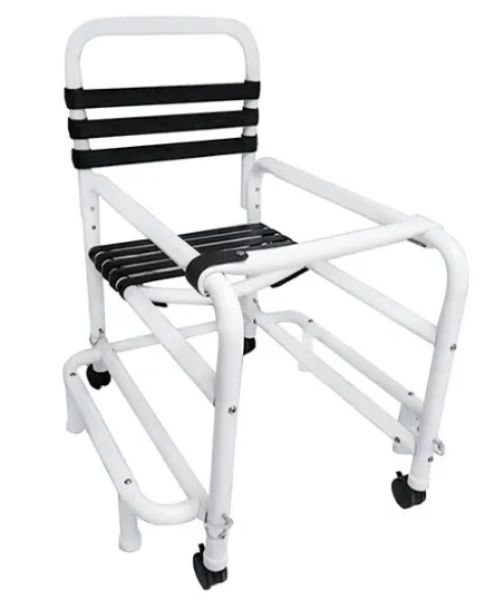
This kind of shower chair is useful for people who can self-propel using their feet. Users are supported and have access to bathing with the added benefit of the independence that comes from being able to propel themselves into and out of the bathroom.
We recommend: Mobile Shower Chair Walker by Mor-Medical
Shower chairs with arms provide convenience to hang things like washcloths, the opportunity for easier transfers with arms for leverage and positioning assistance, and they usually have the option to remove the arms if they impede the user in any way.
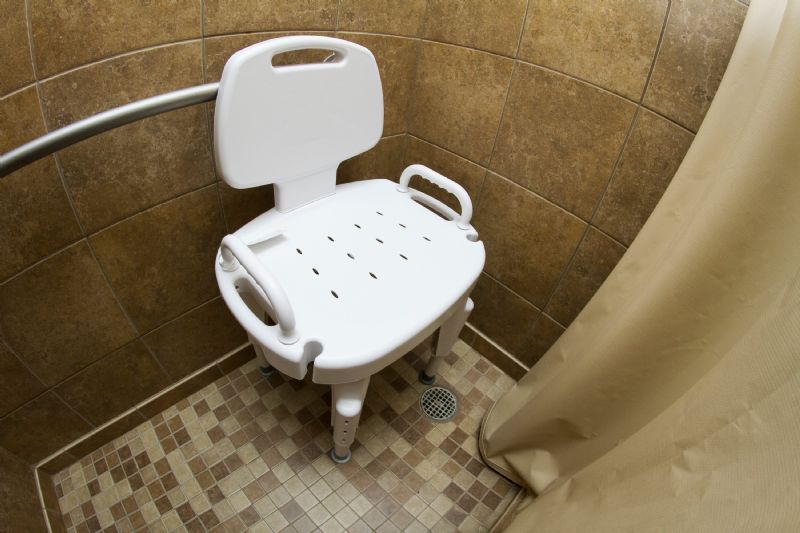
Side handles also provide some space to hang washcloths to keep them within easy reach during bathing. We love that they also provide a grip space without the additional height and mass of armrests.
We recommend: Carex Adjustable Bath and Shower Seat with Back
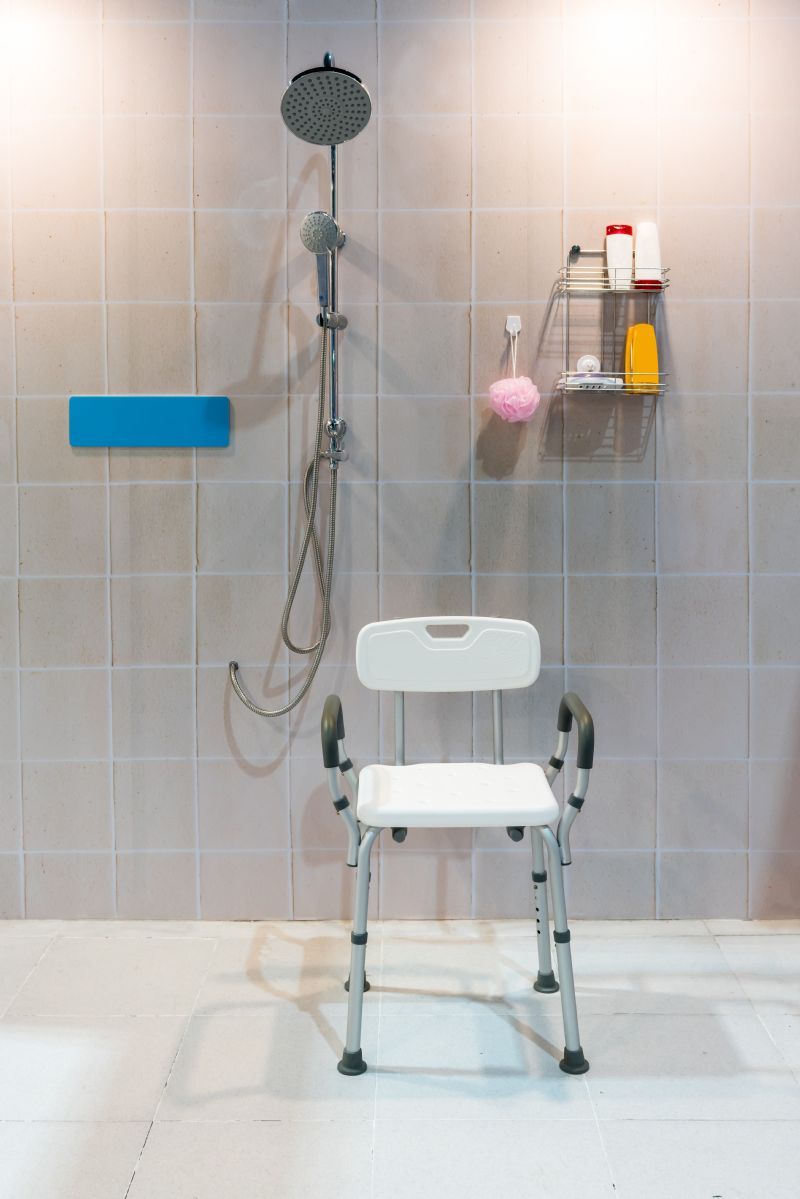
Portability is a convenient feature when you take along a shower seat while traveling or if you want to get it out of the way when it’s not in use. We find this is especially helpful when other people are using the same shower and the chair needs to be moved out of the way and then put back into the shower or tub.
We recommend: Liberty Folding Shower Chair with Swivel Seat by Platinum Health
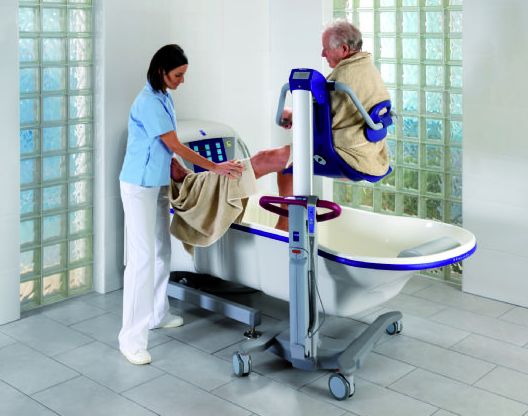
An electric shower chair is as much a benefit to a caregiver as it is to a user. With maximum flexibility of positioning without physical strain, a single caregiver can safely perform all bathing tasks.
We recommend: Alenti Height-Adjustable Bath and Shower Chair by ArjoHuntleigh
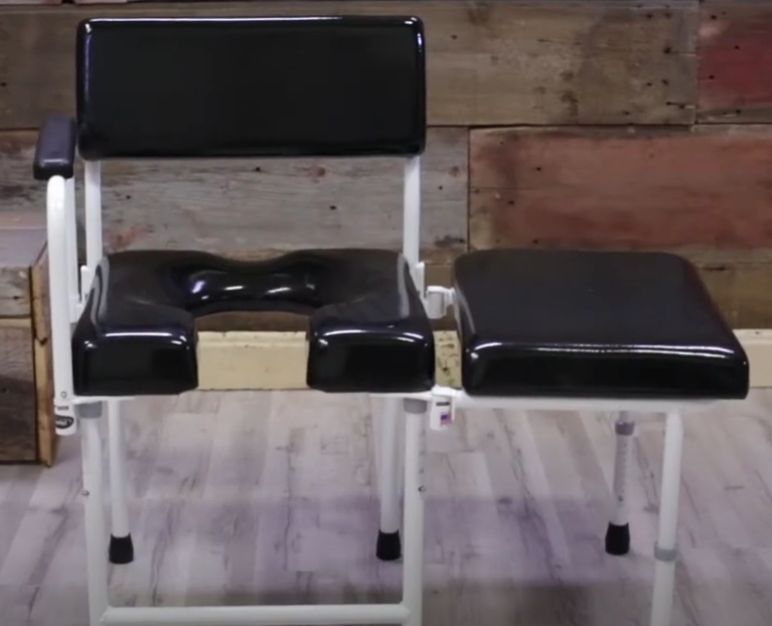
Pressure on the skin from prolonged sitting in one position can lead to uncomfortable and potentially dangerous pressure ulcers. A padded shower chair can alleviate pressure and redistribute body weight for more comfort and less risk of skin issues.
We recommend: Padded Shower Commode Chair with Back
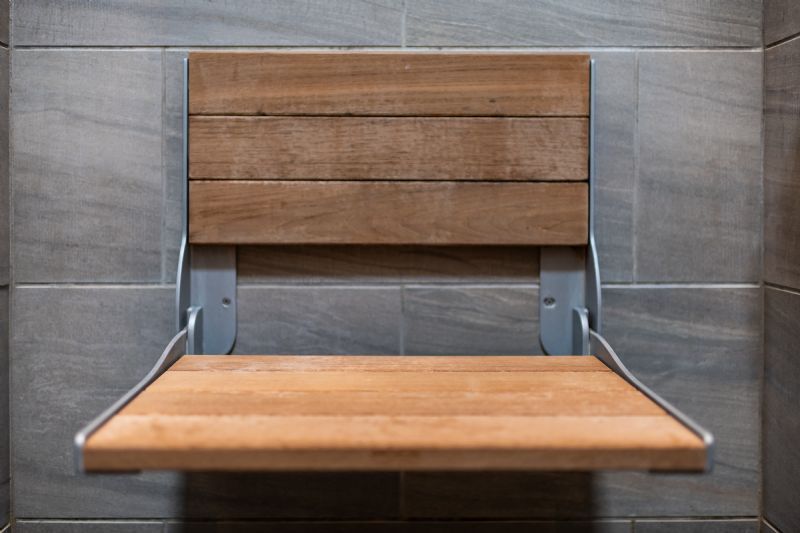
A wall-mounted shower bench eliminates the need to place a shower chair, remove it when not in use, and put it back in the shower or tub when it’s needed. Some wall-mounted shower chairs and benches are supported by adjustable legs while others are supported only by the wall. They are available in plastic, wood, or metal seats with stainless steel frames. View our list of Wall-Mounted Shower Benches for similar products.
We recommend: Teak Wall-Mounted Fold Down Shower Bench
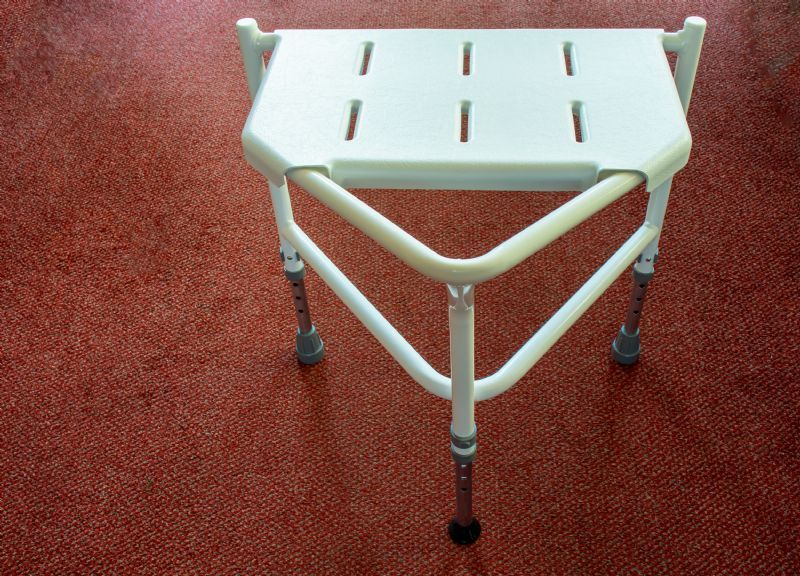
A triangular corner design saves space in the shower, and it can be turned to allow a corner to face forward for greater stability. This design helps relieve pressure on the hips for people recovering from hip surgery. They often tilt slightly to make it easier to stand from a seated position.
We recommend: Etac Edge Shower Stools for Corner
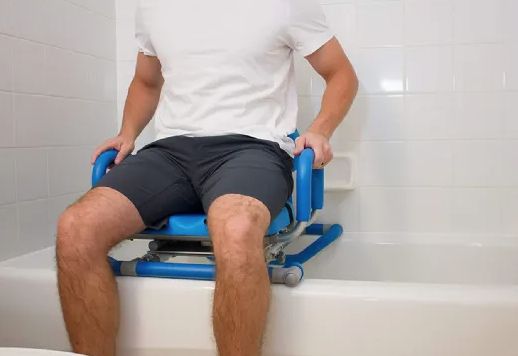
Legless shower chairs attach security to the sides of the bathtub. They have a smaller footprint and there is no need to worry about foot slippage. The user sits on the chair while it faces outward, then swivels around to face the tub, bringing the legs into the bathtub.
We recommend: HydroSlide Swivel Seat Shower and Bath Chair by Platinum Health
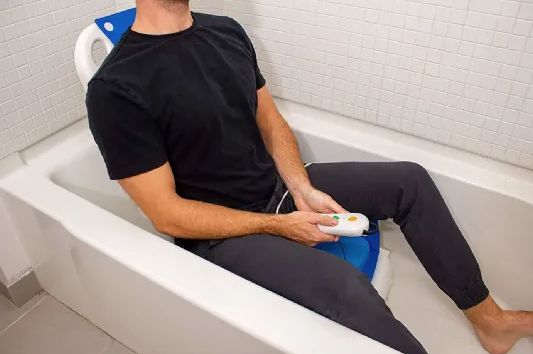
A powered bath lift is an adaptive device that delivers independence and convenience for people who struggle with mobility issues. These electric lifts allow users to enter and exit the tub while also providing stability during baths and showers. The user retains the privacy, dignity, and independence that comes from handling one’s bathing. For information on the best power lifts available with information on how to choose the best option for your situation, read our post on The 5 Best Power Bath Lifts.
We recommend: Tranquilo Electric Reclining Bath Lift by Platinum Health
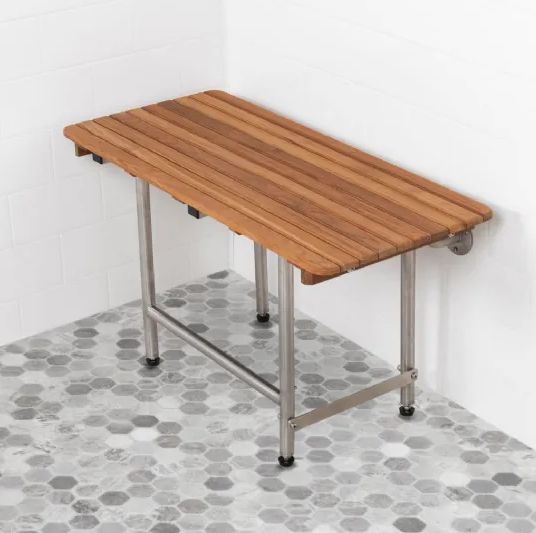
ADA-compliant shower benches are universally accessible, allowing easy entry into a shower. They fold up against the shower wall, and when folded down they provide a safe and secure shower seat. They are required in most facilities and are suitable for home use as well. Read more about the listings in our ADA-Compliant Shower Bench category to see similar products.
We recommend: Teak Shower Bench with Drop Down Legs
As a way to reduce the risk of a dangerous bathroom fall for people with mobility challenges, shower chairs provide safe and comfortable support to facilitate bathing. This can contribute to independence and overall life satisfaction, by allowing people to take care of their personal bathing needs without the fear of a fall. We have more articles on both Shower Chairs and Bathing & Toileting Products that will provide even more useful information as you consider your purchasing options.
Main factors to consider include the overall size and the seat dimensions, weight capacity, height adjustability, materials, style (chair, stool, bench etc.), type of feet, padded or unpadded seat, and swivel or sliding motion.
Thank you for reading our guide on choosing the best shower chair. For more articles on how to make the best product choices for your situation, visit us at Caregiver University.

Co-Founder of Rehabmart and an Occupational Therapist since 1993. Mike has spent his professional career working in multiple areas of Occupational Therapy, including pediatrics, geriatrics, hand therapy, ergonomics and inpatient / outpatient rehabilitation. Mike enjoys writing articles that help people solve complex therapeutic problems and make better product choices.